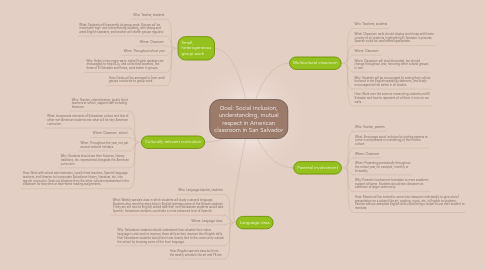Goal: Social inclusion, understanding, mutual respect in American classroom in San Salvador
by Valerie Tidwell

1. Language class
1.1. Who: Language teacher, students
1.2. What: Weekly specials class in which students will study a second language. Students who need the extra help in English (perhaps some of the Korean students if they are still new to English) would take that; non-Salvadoran students would take Spanish; Salvadoran students could take a more advanced level of Spanish.
1.3. Where: Language class
1.4. Why: Salvadoran students should understand how valuable their native language is and work to improve those skills as they improve their English skills. Non-Salvadoran students would feel more closely tied to the community outside the school by knowing some of the local language.
1.5. How: Regular specials class built into the weekly schedule like art and PE are.
2. Small, heterogeneous group work
2.1. Who: Teacher, students
2.2. What: Students will frequently do group work. Groups will be mixed with high- and low-achieving students, with strong and weak English speakers, and teacher will shuffle groups regularly.
2.3. Where: Classroom
2.4. When: Throughout school year
2.5. Why: Helps in two major ways: native English speakers are encouraged to help ELLs, and collectivist societies, like those of El Salvador and Korea, work better in groups.
2.6. How: Desks will be arranged to form small groups conducive to group work.
3. Culturally relevant curriculum
3.1. Who: Teacher, administrators, locally hired teachers at school, support staff including librarians
3.2. What: Incorporate elements of Salvadoran culture and that of other non-American students into what will be very American curriculum.
3.3. Where: Classroom, school
3.4. When: Throughout the year, not just around national holidays.
3.5. Why: Students should see their histories, literary traditions, etc. represented alongside the American curriculum.
3.6. How: Work with school administrators, locally hired teachers, Spanish language teachers, and librarian to incorporate Salvadoran history, literature, etc. into regular curriculum. Seek out literature from the other cultures represented in the classroom for storytime or take-home reading assignments.
4. Multicultural classroom
4.1. Who: Teachers, students
4.2. What: Classroom walls should display world map with home country of all students, highlighting El Salvador in pictures. Spanish could be used where appropriate.
4.3. Where: Classroom
4.4. When: Classroom will start decorated, but should change throughout year, honoring other cultural groups in turn.
4.5. Why: Students will be encouraged by seeing their culture honored in the English-speaking classroom, and thusly encouraged will do better in all studies.
4.6. How: Work over the summer researching students and El Salvador and how to represent all of them in turn on our walls.
5. Parental involvement
5.1. Who: Teacher, parents
5.2. What: Encourage social inclusion by inviting parents to come in and present on something of their native culture.
5.3. Where: Classroom
5.4. When: Presenting periodically throughout the school year, for example, monthly or bi-weekly.
5.5. Why: Parental involvement translates to more academic support at home. Students should see classroom as extension of larger community.
5.6. How: Parents will be invited to come into classroom individually to give a brief presentation on a subject like art, cooking, music, etc. in English to students. Parents without adequate English skills could bring a helper or use their student to translate.


